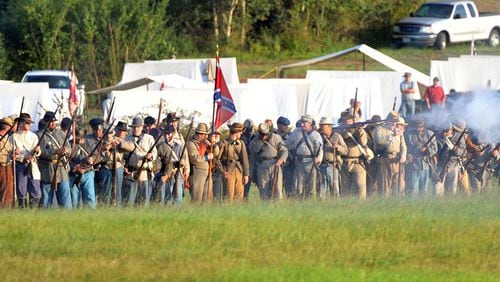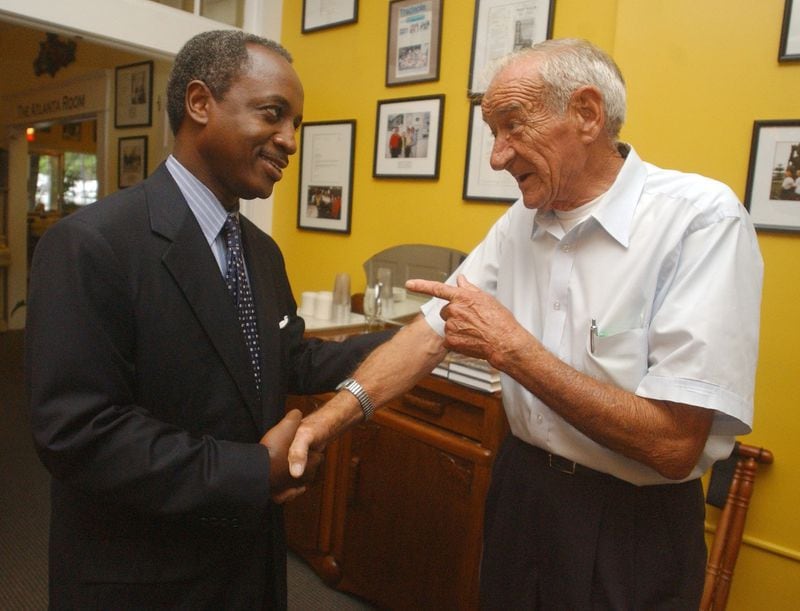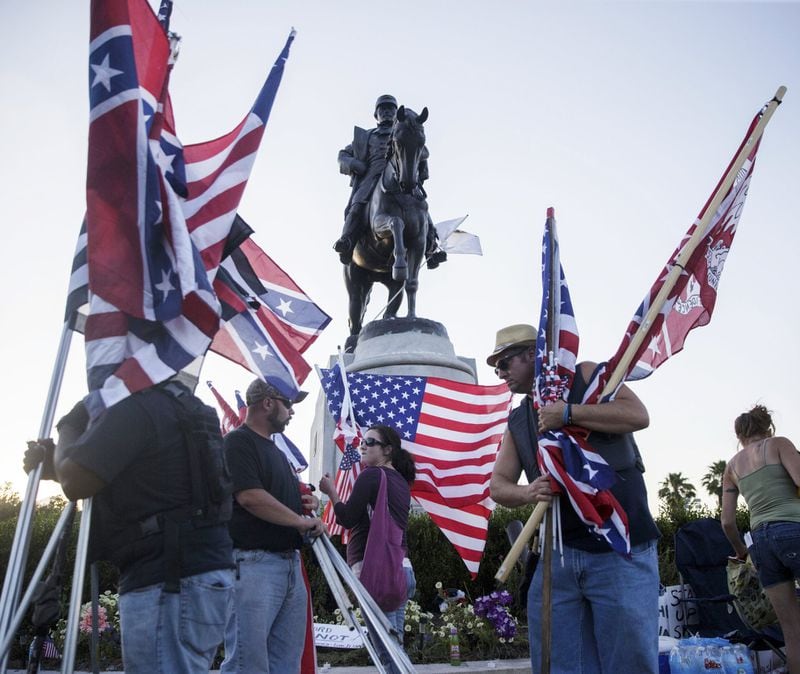The Confederate flag belongs in a museum. President Barack Obama said that.
That is, unless it’s in Henry County.
Last week, yet another Rebel flag fracas unfurled as a hole-in-the-wall history center — the Nash Farm Battlefield Museum — called it quits after a new county commissioner told the facility to take down its Confederate flags, museum people say.
It’s another flash point in an ongoing cultural war, most recently seen in New Orleans when the city removed prominent monuments honoring the Confederacy. For years, towns, counties and even states across the South have faced a question: What place do symbols honoring a failed rebellion, one that fought for the right to subjugate people, have in a modern society?
For years, debates have erupted as streets and schools named for Confederates have been changed, often to honor civil rights leaders. In countless towns, statues and monuments erected to honor a sanitized version of the “Lost Cause” stand as a backdrop.
The Nash Farm museum sits on a 204-acre park/Civil War battlefield site that Henry County bought 10 years ago to stop construction of 399 homes. The $8 million purchase was heralded as a win for a region that usually bulldozed battlefields.
Support was not universal. Jason Pye, a politically active libertarian who has a Rebel ancestor, opposed the move.
“It’s over. The South lost, let it go,” he said at the time. “Until people accept that, people will continue to spend money to honor slavery.”
It seems Commissioner Dee Clemmons, a black woman elected last fall, carries that same belief and was also using the political clout of the growing African-American population that makes up 42 percent of the county. (Whites are 47 percent of the 220,000 residents.)
Early this year, according to museum board member Cassie Barrow, Clemmons told the museum to take down a Confederate flag flying outside. They did.
“We didn’t want to get into a flag battle,” she said.
This month, Barrow said, Clemmons returned and told her the Confederate flags inside the building also had to go.
“That’s where we drew the line,” Barrow said. “A lot of people say take them down and put them in a museum. Well, they were in a museum.”
After that, the man who owned most of the collection said he was taking his stuff and going home. So the museum called it a day.
Clemmons, a Spelman College grad and former teacher, told Channel 2 Action News, "I never asked them to take all of the memorabilia and the replicas that were inside of the museum out."
She said she “requested” the flag be taken down outside and later “asked that (the flags) not be visible from the outside.”
Barrow said flags were not near the windows. She added that Clemmons said nothing about windows; she just wanted the flags gone.
I asked Barrow what Confederate symbols should be deemed acceptable and which are out of bounds.
"I don't know. Who would be the 'What is acceptable' police?" she asked. "Today there always seems to be someone who is being offended by something. It's almost like 'The Twilight Zone.'"
Rod Serling is long gone, so I called Michael Thurmond, who somehow has helped bring a sliver of sanity to DeKalb County’s government. Thurmond, the newly elected CEO, is a veteran politician and a published historian.
“I love Civil War history; it’s a seminal moment in American history,” he said. “It would be a huge mistake not to study, understand and learn from it.”
I asked about the impact of the omnipresent monuments, symbols, statues and obelisks erected in the South in the decades after the War of Northern Aggression.
“It’s very complicated,” said Thurmond. “It goes to the era and the purpose of the obelisk.”
By that, he means after the war, Southerners invented the Lost Cause, a romanticized, sanitized and even mystical view of the ill-fated secession. Slavery was not part of that telling. It was all about honor, nobility, virtue and bravery, a plucky agrarian people fighting an aggressive industrial colossus.
“The South lost the war but won the peace,” Thurmond said. “The propagation of the Lost Cause mythology impeded and delayed the implementation of a New South. History is history, but mythology is a whole different thing.”
Thurmond referred to a speech by New Orleans Mayor Mitch Landrieu, who said the statues “purposefully celebrate a fictional, sanitized Confederacy; ignoring the death, ignoring the enslavement, and the terror that it actually stood for.”
I asked Thurmond about the obelisk behind the old DeKalb courthouse, just blocks from his office.
The inscription, chiseled in 1908, honors Confederate soldiers as “modest in prosperity, gentle in peace, brave in battle and undespairing in defeat, they knew no law of life but loyalty and truth and civic faith, and to these virtues they consecrated their strength.”
The inscription was written by Hooper Alexander Sr., a prominent lawyer, who in 1915 helped set up the deal to start the carving of Confederate heroes on Stone Mountain.
Thurmond read the obelisk recently when attending a ceremony honoring fallen police officers.
Should it be taken down?
“I don’t think you take down the obelisk,” he said. “The obelisk can be a touchstone for a conversation about how racial intolerance led to decades of separation.”
I pushed him on whether it should stand. He laughed off the question. My guess is he’s focused on fixing a water system that’s a mess and filling potholes. Last thing he needs is a fight with flaggers.










